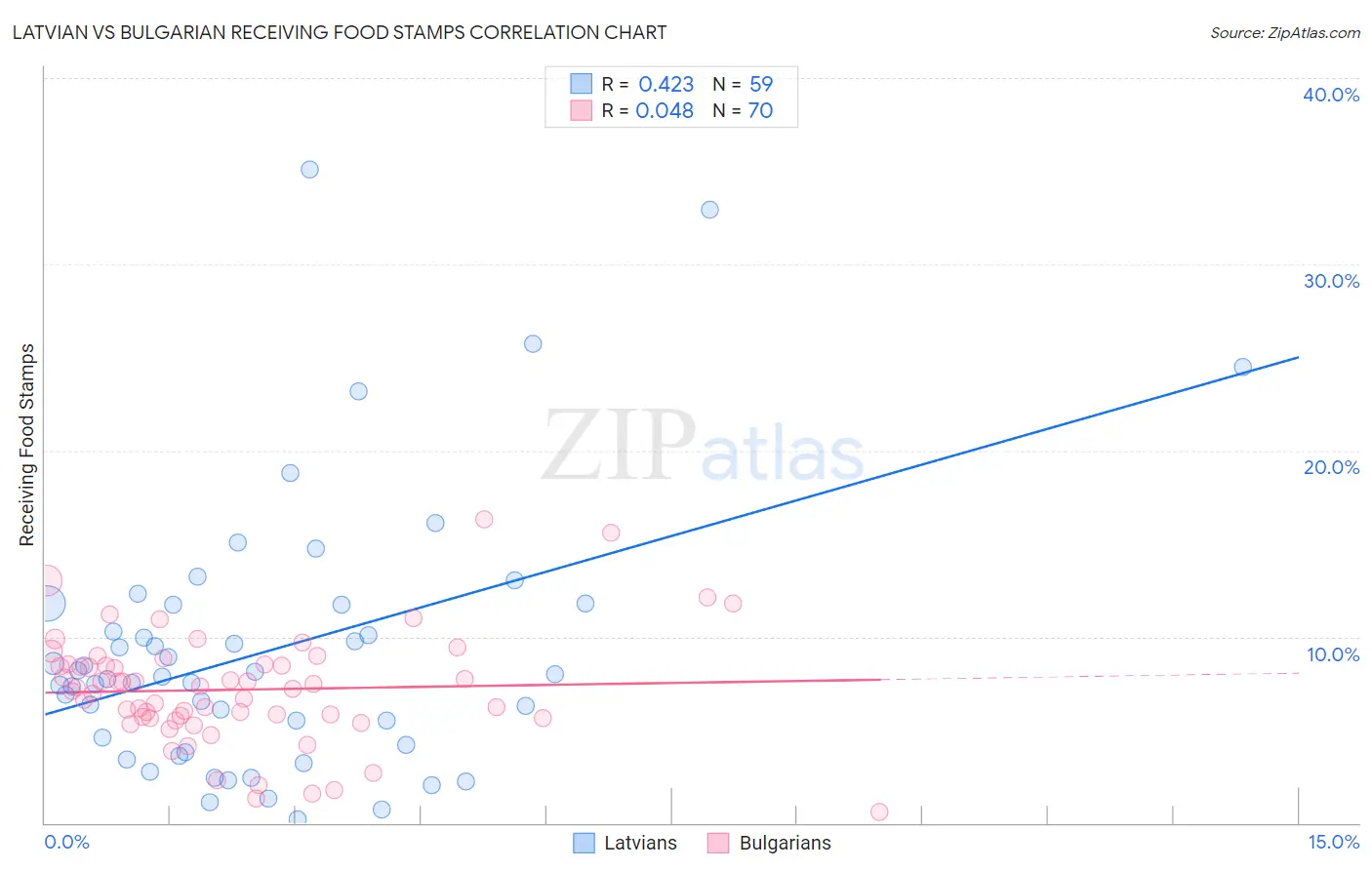Latvian vs Bulgarian Receiving Food Stamps
COMPARE
Latvian
Bulgarian
Receiving Food Stamps
Receiving Food Stamps Comparison
Latvians
Bulgarians
9.1%
RECEIVING FOOD STAMPS
99.8/ 100
METRIC RATING
20th/ 347
METRIC RANK
8.9%
RECEIVING FOOD STAMPS
99.9/ 100
METRIC RATING
13th/ 347
METRIC RANK
Latvian vs Bulgarian Receiving Food Stamps Correlation Chart
The statistical analysis conducted on geographies consisting of 220,272,537 people shows a moderate positive correlation between the proportion of Latvians and percentage of population receiving government assistance and/or food stamps in the United States with a correlation coefficient (R) of 0.423 and weighted average of 9.1%. Similarly, the statistical analysis conducted on geographies consisting of 205,325,342 people shows no correlation between the proportion of Bulgarians and percentage of population receiving government assistance and/or food stamps in the United States with a correlation coefficient (R) of 0.048 and weighted average of 8.9%, a difference of 2.6%.

Receiving Food Stamps Correlation Summary
| Measurement | Latvian | Bulgarian |
| Minimum | 0.20% | 0.60% |
| Maximum | 35.1% | 16.3% |
| Range | 34.9% | 15.7% |
| Mean | 9.3% | 7.2% |
| Median | 7.9% | 7.2% |
| Interquartile 25% (IQ1) | 4.2% | 5.7% |
| Interquartile 75% (IQ3) | 11.7% | 8.5% |
| Interquartile Range (IQR) | 7.5% | 2.8% |
| Standard Deviation (Sample) | 7.2% | 3.0% |
| Standard Deviation (Population) | 7.2% | 3.0% |
Demographics Similar to Latvians and Bulgarians by Receiving Food Stamps
In terms of receiving food stamps, the demographic groups most similar to Latvians are Luxembourger (9.1%, a difference of 0.15%), Immigrants from Hong Kong (9.1%, a difference of 0.33%), Immigrants from Australia (9.2%, a difference of 0.40%), Eastern European (9.2%, a difference of 0.51%), and Immigrants from Northern Europe (9.2%, a difference of 0.54%). Similarly, the demographic groups most similar to Bulgarians are Maltese (8.9%, a difference of 0.13%), Cypriot (8.9%, a difference of 0.19%), Okinawan (8.9%, a difference of 0.20%), Immigrants from South Central Asia (8.8%, a difference of 0.63%), and Norwegian (9.0%, a difference of 0.79%).
| Demographics | Rating | Rank | Receiving Food Stamps |
| Immigrants | Singapore | 100.0 /100 | #6 | Exceptional 8.3% |
| Immigrants | Iran | 100.0 /100 | #7 | Exceptional 8.3% |
| Burmese | 99.9 /100 | #8 | Exceptional 8.6% |
| Immigrants | Korea | 99.9 /100 | #9 | Exceptional 8.7% |
| Immigrants | South Central Asia | 99.9 /100 | #10 | Exceptional 8.8% |
| Okinawans | 99.9 /100 | #11 | Exceptional 8.9% |
| Cypriots | 99.9 /100 | #12 | Exceptional 8.9% |
| Bulgarians | 99.9 /100 | #13 | Exceptional 8.9% |
| Maltese | 99.9 /100 | #14 | Exceptional 8.9% |
| Norwegians | 99.9 /100 | #15 | Exceptional 9.0% |
| Immigrants | Japan | 99.9 /100 | #16 | Exceptional 9.0% |
| Immigrants | Scotland | 99.9 /100 | #17 | Exceptional 9.0% |
| Danes | 99.9 /100 | #18 | Exceptional 9.0% |
| Immigrants | Hong Kong | 99.8 /100 | #19 | Exceptional 9.1% |
| Latvians | 99.8 /100 | #20 | Exceptional 9.1% |
| Luxembourgers | 99.8 /100 | #21 | Exceptional 9.1% |
| Immigrants | Australia | 99.8 /100 | #22 | Exceptional 9.2% |
| Eastern Europeans | 99.8 /100 | #23 | Exceptional 9.2% |
| Immigrants | Northern Europe | 99.8 /100 | #24 | Exceptional 9.2% |
| Immigrants | Ireland | 99.8 /100 | #25 | Exceptional 9.2% |
| Swedes | 99.8 /100 | #26 | Exceptional 9.2% |